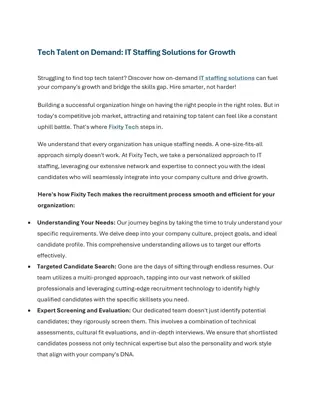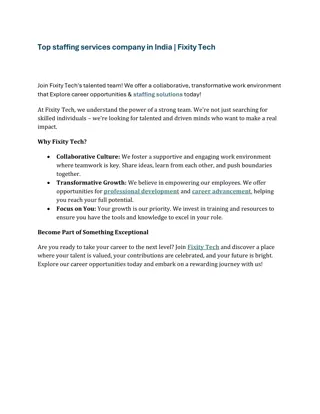
Church Attendance Trends in 2021
Explore insightful statistics on church attendance trends in 2021, including the rise of non-practicing Christians, decline in regular church attendance, and generational differences. Discover how churches can innovate to engage diverse communities effectively.
Download Presentation

Please find below an Image/Link to download the presentation.
The content on the website is provided AS IS for your information and personal use only. It may not be sold, licensed, or shared on other websites without obtaining consent from the author. If you encounter any issues during the download, it is possible that the publisher has removed the file from their server.
You are allowed to download the files provided on this website for personal or commercial use, subject to the condition that they are used lawfully. All files are the property of their respective owners.
The content on the website is provided AS IS for your information and personal use only. It may not be sold, licensed, or shared on other websites without obtaining consent from the author.
E N D
Presentation Transcript
Tech Anew With Director of Communication, Daryl Schreiber
Love tech? Check out the Co+Create Network for Church Admins and Communicators! https://rmcucc.org/cocreate-network/ We meet the third thursday of the month to talk all things church tech and communications. Sessions resume in September.
If Bible Characters had iPhones John Crist and Trey Kennedy break down what it would have been like if Bible Characters had iPhones. John Crist is a standup comedian. For more videos, bio and live tour dates visit http://www.johncristcomedy.com Follow John: http://www.instagram.com/johnbcrist http://facebook.com/johnbcrist http://www.twitter.com/johnbcrist
Church Statistics You Need To Know For 2021 Based on Studies from Gallup and Barna Group Polls
Non-Practicing Christians Are On The Rise Often, you hear statistics about low church attendance. Naturally, you might associate attendance numbers with how many Christians there actually are. However, that s not always the case. In a Barna Group study about how Americans relate to Christianity, the number of non- practicing Christians is rising while the number of practicing Christians is declining. Non-practicing Christians have grown from 35% to 43% from 2000 to 2020. During the same time, practicing Christians declined from 45% to 25%. Non-Christians or agnostic rose from 20% to 32%. The takeaway: there are still Christians out there who are looking for meaningful community. It s up to your church to find innovative ways to reach them!
Regular Church Attendance Declines Based on the previous statistics, regular attendance declining shouldn t be a surprise. The same study found weekly church attendance had declined from 45% in 1993 to 29% in 2020. However, this is an increase from 2017 when weekly attendance was at 27%. It s important to note that any church statistics for 2021 may also be affected by COVID-19. So, it s possible that as things improve that attendance may start to rise gradually as well. We ll look more at how COVID-19 has affected church participation later. Takeaway: Weekly attendance has been declining since well before COVID-19, and we need to consider alternative ways of measuring engagement and church vitality.
Church Attendance By Generation While the Barna Group hasn t included Gen Z yet, the study did show that while church attendance for the four older generations (Elders, Boomers, Gen X and Millennials) rose between 2009 and 2012, it s declined going into 2018 and beyond. Elders, the oldest tracked generation by Barna, is still the most active with 37% attending weekly. Millennials bring up the rear with just 25% attending weekly. Takeaway: Due to changing lifestyles, more people are busy on weekends and may attend in-person worship every other week or once a month. Online services can help boost attendance, more on this later.
Tithing Numbers Some church giving statistics for 2021 might seem low when it comes to tithing, but the tithing issue started long before the pandemic and temporary church closings. In fact, one study found only 5% of churchgoers gave 10% or more of their annual income to church, or any other charity. On the other hand, 50% give up to 2%. While it might not seem like much, those small amounts add up. Plus, it does show that half of Americans are willing to give. The Pew study, which focused heavily on live streaming services, found that 18% of members donated less than usual, while 8% donated more. However, 54% donated approximately the same. 17% didn t donate at all. This shows that continuing to engage members, even when they can t attend in person, can help with giving. Takeaway: Your church needs to make giving as easy as possible. Offering online giving is a great way to help boost tithing and gain financial stability for your church.
Income a Top Issue Facing Churches Despite around half of church members still giving the same amount, half aren t. This is why 60% of Church Executive study respondents said the church s finances were a top issue for them. Catholic churches responded the highest to this issue with 67% saying it was a major problem they re facing. Takeaway: Stewardship campaigns and regular appeals for giving will continue to be essential for maintaining your church s financial health.
Church Unity A Problem During The Pandemic With so much misinformation floating around, it s not surprising that churches are facing a unity problem in getting everyone on the same page with pandemic rules and restrictions. Only 9% of churches said they didn t have any divisiveness within their church. Another Church Executive study found that 73% of churches say leaders agree on a coronavirus strategy. However, their members weren t as agreeable with the following causing disagreements and issues: In-person gatherings (34%) Wearing masks (19%) Worship styles (13%) Conspiracy theories (13%) Takeaway: The need for communication and conversation across a variety of divides is an essential part of the church s future.
How COVID-19 has affected Peoples Faith With churches closing their doors during the early months of COVID-19, many pastors were worried that their members might lose their faith. This is especially true for anyone being more directly impacted by COVID-19, such as losing a loved one. However, pastors in one study said 64% of their members stayed the same in terms of their faith. Pastors also said 14% may not be quite as faithful as before. A promising number, 22% to be exact, are actually growing in their faith, showing that people still need churches to be there to help them grow. Takeaway: A crisis can be an opportunity to deepen faith and religious practices for some.
People Experimented With Different Churches during Covid-19 Since so many churches opted for live streaming during the pandemic, Christians took advantage to check out other churches. In fact, the Pew study showed 42% watched services from a church other than their own. The same percentage of Catholics did the same. Takeaway: Your church might see more visitor traffic when offering online worship options.
COVID-19 Attendance Changes Vary By Church Size Most coronavirus church attendance statistics focus on all churches, but that doesn t always properly represent churches of different sizes. The Church Executive study discovered churches with 50-149 members saw more decreases with 42% reporting a slight decrease and 16% reporting larger decreases. 34% of churches with 1-49 members saw a slight decrease, but 37% reported steady attendance. Even 21% saw a slight increase. Churches with 350 or more members had the least negative impact and the highest growth. Takeaway: Larger churches likely had more resource to convert to online worship quickly, versus smaller churches.
Online Worship Leads To Growth A common reason many churches never tried live streaming before the pandemic is they didn t think it d provide any growth potential. However, churches that implement online worship may experience exponential growth. In one case study covering several churches use of live streaming, Georgia s Redeemer Church grew from around a dozen members to over 1,000 in a year. And, they also get viewers from over 17 countries worldwide. Texas-based church Current was able to reach upwards of 130 more people with live streaming. Those are 130 more potential in-person visitors as well. Takeaway: Even when folks can attend in-person worship, you re still able to reach far more people with online worship options, which can lead to growth offline and increased giving.
Live Streaming Increases Online Tithing This might be one of the most important church statistics for 2021. Live streaming helps you reach a much larger audience, many of which can t or won t attend in person. However, that doesn t mean they re not a part of your church. Champions Centre church started live streaming to help grow their church reach. Not only did they grow their viewership, but they also increased online tithing by 70%. Takeaway: Your members don t actually have to be in your church to be a part of your church. They can participate and donate in many of the same ways as your in-person members, helping your church grow globally.
Online Attendance Is Higher Than In-Person While only around half of churches tracked their online attendance initially during COVID-19, the other half discovered that online attendance is a little higher than in- person attendance. Rev. David Bahr tracked how his sermon viewership changed during the pandemic and it was a significant increase in attendance. It wasn t a huge jump, but online views when churches initially went to online-only was 8% higher than in-person attendance before churches closed. Takeaway: Providing online worship options can lead to increased viewership and participation in church.
In-person Attendance Still Recovering From COVID-19 Depending on your church, state, and county, church attendance may be far from pre-COVID levels or getting close to being normal. Carey Nieuwhof put together several telling church statistics for 2021: Churches are back at 36% of what they were on average (Q3 UnStuck Church Report) Only 52% of church-goers want primarily in-person services again (Barna) 71% of Boomers want primarily in-person services (Barna) Less than 50% of Gen X (47%), Millennials (42%) and Gen Z (41%) want in-person services Takeaway: Preferences regarding in-person worship vary greatly based on your geographical area and your congregation s preferences. The best way to gauge interest in returning to in-person services is to send out a survey to your members.
Hybrid Church Services Could Be The New Norm Just 21% of church leaders had a solid digital strategy in place before and during COVID-19. However, the trend towards a hybrid church is growing, especially as more people have experienced the convenience of online services during the pandemic. A Barna study shows 35% of all church-goers surveyed liked both in-person and online services. 9% preferred online-only. A Church Executive study found 74% of churches are opting for a hybrid model that involves a combination of online, and in-person and social distanced models. One of the more positive church statistics for 2021 is how happy church members have been with live streamed services. The Pew study found 91% were satisfied with what their churches were doing. So, keep up the great work! Takeaway: providing both in-person and online worship helps you meet the needs of everyone.
Social Media Valuable Tool During Pandemic Churches that might not have used social media before have found it to be a valuable tool for engagement and connection. The Church Executive study found that 80% of churches were successfully using social media to help them stay connected with members. Rev. Marta Fioriti and Mandy Todd have used social media to engage their church members and create engaging, out of the box ways to be the church during COVID-19. Check out the Black Forest Community Church and the Jesus has Left the Building page for ideas! Takeaway: Social media can help integrate spiritual practice into your congregants daily life, as well as help you stay connected while physically distancing.
Sermons Matter Most A Gallup poll found that the deciding factor as to whether someone attends church or not is the sermon content. 75% reported they preferred sermons relevant to their lives, while 76% reported enjoying sermons that teach scripture. Takeaway: This is another reason to post or livestream your sermons online so potential church-goers are able to see if your sermons meet their needs.
Community Matters Also The same Gallup poll found that community programs, both for members and non- members, were incredibly important when choosing a church. Takeaway: Even if you have great sermons, those looking for a church are also interested in: Community outreach and volunteer opportunities (59%) Social activities for the community (49%) Spiritual programs for kids and teens (64%)
Prayer Is Still Important One thing practicing and non-practicing Christians agree on is prayer. The Barna Group study found 69% of Christians had prayed within the last week. This is only a small decline from 83% in 1996. The number has actually stayed fairly steady for the last eight years. Takeaway: One way your church might connect to more folks is by offering regular online prayer options.
Major Takeaways Giving remains a top concern for churches. In-person worship service attendance varies by age group. Changing lifestyles are contributing to lower Sunday service attendance. A digital presence is a necessity for engaging with your members and helping grow your church. Online/In-person hybrid models will become the new normal for churches, even after COVID-19. Source: https://reachrightstudios.com/25-church-statistics-for-2021/#h-7-live-streaming-leads-to-growth
New Tech in the Church The church jobs and tech of the future!
New Roles in the Church Director of Digital Media Digital Ministry Coordinator Livestream Worship Tech Multimedia Ministry Coordinator Digital Faith Formation Technical Arts Director Digital Communications Coordinator
NEW Tech in the Church Streaming Cameras OTT Streaming Services Online giving platforms Custom Church Apps Responsive Web Design Experiential Video calling
Group Questions Church Stats in 2021 Does your church plan to continue online services in some format after all COVID-19 restrictions are lifted? Does any of the information in this presentation make you rethink your church s strategy? What area of your church s ministry has been most impacted by COVID-19, and has technology helped you overcome it? Tech Anew How have job title and/or roles changes in your church? Are there any tech anew platforms you have tried or want to try in your church?






















